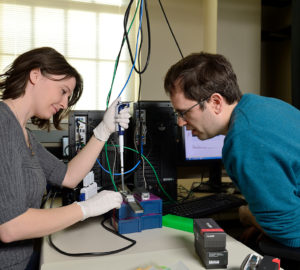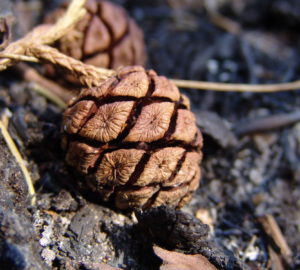
Conservation is always evolving to keep up with ever-changing environmental challenges and new threats.
Today, we recognize that in addition to protecting our iconic, old-growth redwood forests, we need to restore historically logged areas. We need to ensure that the young forests that dominate the coast redwood range are regrowing in a healthy way and that they can become majestic ancient redwoods that future generations can experience and enjoy. We can do that by accelerating the growth of small redwoods and protecting their genomic diversity at the same time.
First Step: Sequencing the Redwood Genomes
Announced this week on April 23, Save the Redwoods League, University of California, Davis, and Johns Hopkins University have unlocked the genetic codes of our coast redwood and giant sequoia forests. Together, we have sequenced the genomes of both tree species, a major milestone for our Redwood Genome Project and a giant leap toward achieving our ultimate goal of protecting these iconic California forests.
The coast redwood genome is now the second largest ever sequenced at nine times the size of the human genome. The genome of the giant sequoia is about three times that of the human genome.

Applying this Scientific Research in our Restoration Efforts
Because we don’t know which trees will be successful in the future, the forests’ resilience to continual environmental change will come from us protecting as many genetically unique individuals as we can. We can do this best by using technology based on the genome sequences completed this week to screen forests for genomic diversity.
Every time we plant a tree or thin the forest, we potentially increase or decrease the genomic diversity of the redwood population. With this new, emerging technology at hand in the coming years, forest stewards will be able to refine their forest management practices with new insight at their disposal.
Maybe there are young seedlings growing unassumingly in the forest today that are uniquely suited to tolerate intense droughts in the future — we want to find them and protect them as we seek to sustain the old-growth trees and accelerate the recovery of logged forests across the landscape.
Learn more about the Redwood Genome Project and our collaborative effort to restore the historically logged forests within Redwood National and State Parks.

2 Responses to “Seeing the Forest for the Genes”
Michael McLaughlin
Because the Parks constitute a tiny percentage of the recent historical sempervirens forest, and those parks are themselves artificially limited, considerable effort must be established to return the bulk of presently logging company ‘owned” forests stretching from Del Norte through Mendocino, to public ownership, and creating a protected genetic corridor through to the southern population in Monterey County.
We know that S. sempervirens have been planted as far north as Washington, but habitat fragmentation and the failure to regard the lives of trees and symbiotes as having validity is a cultural problem that will continue their vulnerability to levels at which unwarranted extinction remains likely for the foreseeable future.
Unless, of course, mandated protection occurs at the level I’ve indicated, until the culture can be changed toward greater inclusivity.
Ecuador, as an example, has written an overly vague provision into their Constitution of the rights of nature. More specificity is required, and the present Euroamerican culture has relegated trees to mere commodity, to be killed for individual or investor profit without any concern whatsoever.
Modern scientific research shows considerable sensory capacity and responsiveness in plants. We also are beginning to understand the communal sharing of resources in which they participate. I do not suggest that humans completely abandon their excessive hubris, as that seems to arouse irrational fear and consequent ill will, but a culture that respects life sufficiently not to take it for cosmetic or social status (read: financial profit) reasons will be vitally necessary to develop or reacquire.
RANDELL MORELLI
That’s so cool can’t wait till I can plant some redwoods on my property in Door County wisc. Thank You for your work